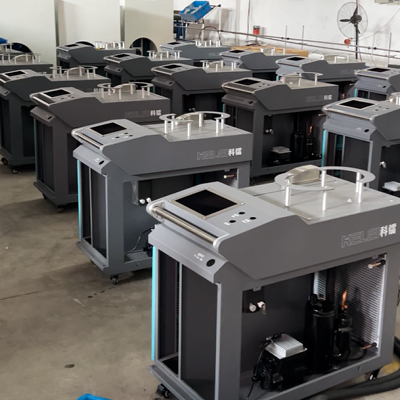I. Inspection of External Environment and Equipment appearance
Clear the surrounding environment and remove any obstacles within 1 meter around the unit (such as debris, tools, flammable materials). Ensure that the ventilation outlets are unobstructed. The condenser and radiator need to maintain air circulation. If they are blocked by dust and debris, it will lead to a decrease in heat dissipation efficiency and cause high-pressure alarms for the unit. At the same time, check whether there is any accumulated water or corrosive liquids on the floor and walls of the computer room to prevent short circuits of electrical components or rusting of equipment casings.
Check the condition of the equipment foundation. Observe whether the unit body is tilted and whether the anchor bolts are loose (they can be tightened with a wrench). If the foundation settles after long-term operation, it may cause the vibration of the compressor and pipelines to intensify, leading to interface leakage. In addition, check whether the insulation layers of the casing and pipelines are damaged. If the insulation fails, it will increase the loss of cooling capacity and affect the refrigeration efficiency.
Ii. Electrical System Safety Inspection (Power-off Operation Required)
Inspection of circuits and terminal blocks
Open the electrical control cabinet and check whether the power lines and control lines are aged, damaged or peeling. Pay special attention to inspecting whether the connection terminals (such as those of compressors, fans and solenoid valves) are loose or oxidized. Loose terminals can lead to poor contact, cause local overheating and even burn out the motor.
Insulation and grounding test
Use a multimeter to test the insulation resistance of the motor winding (normally it should be ≥0.5MΩ). If the resistance is too low, there may be a risk of winding moisture or short circuit. At the same time, check whether the grounding device is firm. The grounding resistance should be ≤4Ω to avoid leakage and cause safety accidents.
Functional verification of control components
Before powering on, manually test the key components: such as whether the pressure gauge and temperature sensor are reset to zero, whether the contacts of the relay and contactor are oxidized (fine sandpaper can be used for grinding), and whether the emergency stop button can be triggered normally. If the temperature controller and pressure controller fail, it may cause the unit to operate at excessive temperature and pressure.
Iii. Core Inspection of the Refrigeration System
Refrigerant leakage detection
Apply soapy water to the pipe joints (such as the connection points of condensers, evaporators, valves and filters) and observe whether there are any bubbles produced. If the unit is equipped with a leak detector, the leakage point can be directly detected (the leakage volume should be ≤0.5g/year). If leakage is detected, it is necessary to repair the leak first and then replenish the refrigerant to the standard pressure (depending on the type of refrigerant, such as R410A or R22, refer to the unit manual).
Pressure and valve status inspection
Check the readings of the high and low pressure gauges: When the machine is shut down, the high and low pressure should be balanced (for example, when the ambient temperature is 25℃, the static pressure of R410A is approximately 1.8MPa). If the pressure is too low, there may be leakage or insufficient refrigerant. If the pressure is too high, it is necessary to check whether there is a blockage in the pipeline. At the same time, make sure that all valves (such as the liquid supply valve, return valve, and solenoid valve) are in the "open" position (manual valves need to be turned counterclockwise to the bottom, and the solenoid valve is powered on to test if it operates), to avoid the unit running without load due to valve closure.
Heat exchanger cleanliness inspection
To clean the dust and willow catkins on the surface of the condenser (air-cooled type), compressed air (pressure ≤0.4MPa) can be used to blow from the inside out. For water-cooled condensers, it is necessary to check whether the inlet and outlet of the cooling water are unobstructed and whether the water quality is turbid (if there is too much scale, it should be cleaned with a descaling agent). If frost forms on the evaporator, it is necessary to defrost it before starting it to avoid the frost layer affecting the heat exchange efficiency.
Iv. Inspection of the lubrication system and auxiliary Equipment
Inspection of lubricating oil level and quality
Check the oil level in the compressor oil sight glass. The oil level should be between the "high" and "low" marks. (If the oil level is too low, add the same type of refrigeration oil and do not mix different brands.) At the same time, observe the oil quality: Normal oil is clear and transparent. If it is black, turbid or contains impurities, the lubricating oil should be replaced immediately (the oil filter needs to be cleaned when replacing).
Inspection of the oil differential pressure controller
To test whether the oil differential pressure controller is sensitive: Manually press the differential pressure switch before starting. If the protection can be triggered normally, it indicates that the controller is effective. If the oil differential pressure is insufficient (normally it should be ≥0.15MPa), it will cause poor lubrication of the compressor and lead to wear of the components.
Check the status of auxiliary equipment
Check whether the cooling fan and water pump can operate normally (manually rotate the impeller to ensure there is no jamming). If condensation or frosting occurs on the drying filter, it may indicate that the internal filter element is clogged. The filter element needs to be replaced to prevent impurities from entering the refrigeration system.


